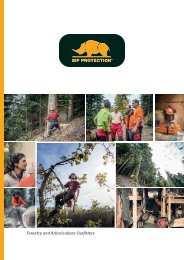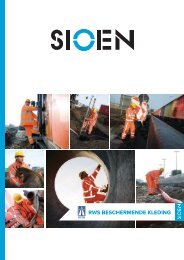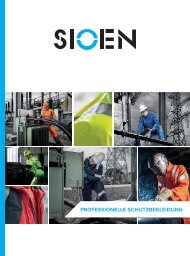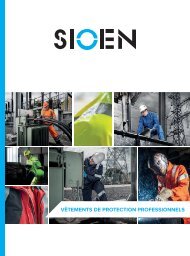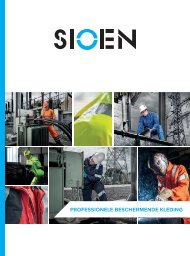- Page 1:
PROFESSIONAL PROTECTIVE CLOTHING
- Page 4 and 5:
How to use this catalogue All weath
- Page 6 and 7:
Quick guide | Symbols & Icons Find
- Page 9 and 10:
All weather ALL WEATHER
- Page 11 and 12:
All weather ALL WEATHER Gear up for
- Page 13 and 14:
ALL WEATHER Table of content 1 2 3
- Page 15 and 16:
ALL WEATHER BODYWEAR - WARM & DRY
- Page 17 and 18:
ROJA 500AA2MD6 ODARS 499AA2MD6 ALL
- Page 19 and 20:
ALL WEATHER Verde T-shirt with long
- Page 21 and 22:
Ferano T-shirt with long sleeves 51
- Page 23 and 24:
ALL WEATHER Toro Tortolas Pular 29
- Page 25 and 26:
Treviso Pullover 2691A2MV6 ALL WEAT
- Page 27 and 28:
Tarbes Bestseller 7789A2T01 Fleece
- Page 29 and 30:
ALL WEATHER Tortolas Bestseller 443
- Page 31 and 32:
INTERCHANGEABLE LINING SYSTEM ALL W
- Page 33 and 34:
Germo Quilted jacket with fleece li
- Page 35 and 36:
ALL WEATHER Pulco Bonded softshell
- Page 37 and 38:
ALL WEATHER Homes 9934A2TU1 Laminat
- Page 39 and 40:
ALL WEATHER THERMAL WEAR - GARMENT
- Page 41 and 42:
FRANKFURT 1789A2FE0 DORTMUND 4820A2
- Page 43 and 44:
Frankfurt Rain jacket 100% waterpro
- Page 45 and 46:
BIELEFIELD 4265A2FE0 SURAKARTA 6604
- Page 47 and 48:
Bandung Bestseller 6620A2FE0 Bib an
- Page 49 and 50:
ALL WEATHER DORTMUND 4820A2FC1 ROTT
- Page 51 and 52:
Dortmund Bestseller 4820A2FC1 Rain
- Page 53 and 54:
Amsterdam 4899A2F01 Winter rain jac
- Page 55 and 56:
MONTREAL 4964A2FC1 CONFIDENCE IN TE
- Page 57 and 58:
Auckland Leggings 4570A2FC1 CONFIDE
- Page 59 and 60:
ALL WEATHER Brest 1692A2B01 Rain ja
- Page 61 and 62:
VENTRY 701AA2B17 ALL WEATHER Ventry
- Page 63 and 64:
ALL WEATHER Roosky New Hi-vis hip w
- Page 65 and 66:
ALL WEATHER Hawk Bestseller 027AA2P
- Page 67 and 68:
Treban Bestseller 193AA2X75 Winter
- Page 69 and 70:
Rowe 3 in 1 rain jacket with detach
- Page 71 and 72:
Crossfield 3 in 1 winter jacket wit
- Page 73 and 74:
ALL WEATHER HICKS 697ZA2ES3 Hicks R
- Page 75 and 76:
Sheffer Rain jacket 698ZA2X98 ALL W
- Page 77 and 78:
MILLS 441AA2EU1 ALL WEATHER Mills W
- Page 79 and 80:
Tempa Winter bomber jacket with det
- Page 81 and 82:
ps: 4 in 1 multifunctional jacket A
- Page 83 and 84:
4 in 1 multifunctional jacket ALL W
- Page 85 and 86:
ALL WEATHER Tornhill Bestseller 608
- Page 87:
Tomar Rain trousers 654ZA2LH2 ALL W
- Page 90 and 91:
1 2 BODYWEAR 94 THERMAL WEAR 102
- Page 92 and 93:
RONAN 5887A2EU1 FULLER 9933A2TU1
- Page 94 and 95:
Bodyw ear BODYWEAR - BASIC LINE New
- Page 96 and 97:
BODYWEAR - SIO-COOL ® LIGHT New A
- Page 98 and 99:
BODYWEAR - SIO-COOL ® CLASSIC New
- Page 100 and 101:
Sizes: S - XXXL LOXTON 439AA2PEC 10
- Page 102 and 103:
Thermal wear HI-VIS PULLOVERS Monte
- Page 104 and 105:
Monterey ivis fleece sweater 9852A2
- Page 106 and 107:
TARVISO 5841A2EJ4 KINGLEY 497ZA2T01
- Page 108 and 109:
Thermal wear THERMAL WEAR - S.E.P.P
- Page 110 and 111:
RONAN 5887A2EU1 SENIC 711ZA2T01 Mow
- Page 112 and 113:
RONAN 5887A2EU1 DEXTER 722ZA2TU2 Bo
- Page 114 and 115:
Genova Bestseller 9833A2TU2 Hi-vis
- Page 116 and 117:
BURTON 169AA2EU1 FLENSBURG 4448A2EJ
- Page 118 and 119:
SENS 9351A2FE0 Arras Bestseller 114
- Page 120 and 121:
Rainwear RAINWEAR - FLEXOTHANE ® E
- Page 122 and 123:
Erfurt 1785A2FE0 Hi-vis rain jacket
- Page 124 and 125:
Arlon 6575A2FE0 Hi-vis rain trouser
- Page 126 and 127:
Merapi Hi-vis winter rain jacket (R
- Page 128 and 129:
Unzen Hi-vis rain jacket 3720A2F01
- Page 130 and 131:
GREELEY 6580A2FF5 LASSEN 3763A2FC1
- Page 132 and 133:
AOBA 6669A2FC1 LASSEN 3763A2FC1 Aob
- Page 134 and 135:
Dortmund (HV) Hi-vis rain jacket 48
- Page 136 and 137:
Pinatubo Hi-vis winter rain jacket
- Page 138 and 139:
TARVISO 5841A2EJ4 SPARROW 029AA2PBE
- Page 140 and 141:
Rainwear RAINWEAR - SIOPOR ® Regul
- Page 142 and 143:
Monoco New Hi-vis rain jacket 598ZN
- Page 144 and 145:
Belvill Hi-vis rain jacket 798ZA2X9
- Page 146 and 147:
Rainwear RAINWEAR - SIOPOR ® Ultra
- Page 148 and 149:
RONAN 5887A2EU1 MALBRO 347AN2ES3 Ba
- Page 150 and 151:
INTERCHANGEABLE LINING SYSTEM Creat
- Page 152 and 153:
RONAN 5887A2EU1 ALFORD 168AA2EU1 15
- Page 154 and 155:
GLISY 595AA2EU1 ALFORD 568AA2EU1 To
- Page 156 and 157:
Boorne Hi-vis rain jacket (RWS) 350
- Page 158 and 159:
Campbell Bestseller 364AN3EX1 Hi-vi
- Page 160 and 161:
Skollfield Bestseller 209AN2X93 Hi-
- Page 162 and 163:
Powell Bestseller 401AN3EU1 Hi-vis
- Page 164 and 165:
Hobson Hi-vis winter bomber jacket
- Page 166 and 167:
RAINWEAR - SIOPOR ® Strong SIOPOR
- Page 168 and 169:
RAINWEAR - SIOPOR ® Extra SIOPOR
- Page 170 and 171:
RAINWEAR - S.E.P.P The S.E.P.P. (Si
- Page 172 and 173:
CONFIDENCE IN TEXTILES Tested for h
- Page 175 and 176:
MULTINORM Multi-norm protection Fla
- Page 177 and 178:
Multi-norm A top-notch protection i
- Page 179 and 180:
Flame retardant The key feature of
- Page 181 and 182:
Teramo Bestseller 2690A2MPB Flame r
- Page 183 and 184:
FR MULTINORM Candiz 319AA2MR1 Flame
- Page 185 and 186:
RAINIER 496ZN2TF1 GLADSTONE 5729A2E
- Page 187 and 188:
FR MULTINORM Liberchies Flame retar
- Page 189 and 190:
Dampremy Bestseller 7771A2TF1 Flame
- Page 191 and 192:
NEVADA 6507N2FF1 ALABAMA 1798N2FF1
- Page 193 and 194:
NEVADA 6507N2FF1 ALABAMA 1798N2FF1
- Page 195 and 196:
4 Flame retardant + anti-static Des
- Page 197 and 198:
Beltane Bestseller 2690A2MPC Flame
- Page 199 and 200:
POLTON 519AA2MPC WELLSFORD 4691N2EF
- Page 201 and 202:
ELTOW 318AA2MPC Sweat Supple FR AST
- Page 203 and 204:
Senra New 494AA2MF0 Flame retardant
- Page 205 and 206:
VALIER 9896A2TF2 FR AST MULTINORM K
- Page 207 and 208:
PLAYFORD 9633N2TV4 Heatherton 9643A
- Page 209 and 210:
SIDNEY 9387A2EF3 FR AST MULTINORM S
- Page 211 and 212:
INTERCHANGEABLE LINING SYSTEM Creat
- Page 213 and 214:
MONTERO 009VA2PFA FR AST MULTINORM
- Page 215 and 216:
ALTEA 003VA2PIF GIMONT 001VA2PIF FR
- Page 217 and 218:
FR AST MULTINORM Novara Flame retar
- Page 219 and 220:
AVERSA 007VA2PIF FR AST MULTINORM S
- Page 221 and 222:
GREELY 6580A2FF5 ANDILLY 9728A2FF5
- Page 223 and 224:
GREELY 6580A2FF5 ANDILLY 9728A2FF5
- Page 225 and 226:
ELLISTON 7219A2EF7 FR AST MULTINORM
- Page 227 and 228:
Waverly Flame retardant, anti-stati
- Page 229 and 230:
BRISBANE 6133A2EF5 ELLISTON 7219A2E
- Page 231 and 232:
BRISBANE 6133A2EF5 MAREX 9464N2EF5
- Page 233 and 234:
Delano Flame retardant, anti-static
- Page 235 and 236:
TIELSON 5874N2EF5 ELLISTON 7219A2EF
- Page 237 and 238:
EKOFISK 5806A2EF3 DUFFEL 3074N2EF7
- Page 239 and 240:
Glenroy Flame retardant, anti-stati
- Page 241 and 242:
INTERCHANGEABLE LINING SYSTEM HEDLA
- Page 243 and 244:
Oregon Flame retardant, anti-static
- Page 245 and 246:
MULTINORM Geralton Flame retardant,
- Page 247 and 248:
Durant 7237A2ET1 Flame retardant, a
- Page 249 and 250:
KAMBER 7235A2ET1 FALCON 7229A2ET1 F
- Page 251 and 252:
Talbot New Flame retardant, anti-st
- Page 253 and 254:
Arc Protection An electric flashove
- Page 255 and 256:
Arc protection thermal wear ARC CAP
- Page 257 and 258:
Urbino New Fleece sweater with ARC
- Page 259 and 260:
Playford Bestseller 9633N2TV4 Hi-vi
- Page 261 and 262:
ANACO 016VN2PFA ARC MULTINORM Milla
- Page 263 and 264:
Zarate Trousers with ARC protection
- Page 265 and 266:
Anaco Coverall with ARC protection
- Page 267 and 268:
ANACO 016VA2PFA MULTINORM Carlow 01
- Page 269 and 270:
Bayonne 015VN2PFA Hi-vis bib & brac
- Page 271 and 272:
AUTUN 018VA2PFA Larrau Arudy Viana
- Page 273 and 274:
VARESE 021VN2PF9 MODENA 019VA2PF9 A
- Page 275 and 276:
MULTINORM Reggio 020VA2PF9 Matour 0
- Page 277 and 278:
Ambier 024VN2PF9 Hi-vis bib & brace
- Page 279 and 280:
LARRAU 020VA2PFD ARC MULTINORM SIO-
- Page 281 and 282:
ARUDY 022VA2PFD LARRAU 020VA2PFD MU
- Page 283 and 284:
VILLIERS 029VN2PU2 EFFIAT 027VA2PU2
- Page 285 and 286:
MULTINORM Villiers Bib & brace with
- Page 287 and 288:
GILLES 7232A2LE8 NEWTON 7240A2LE9 A
- Page 289 and 290:
KAMBER 7235A2ET1 NASH 7227A2ET1 MUL
- Page 291 and 292:
NASH 7227A2ET1 ARC MULTINORM Derby
- Page 293 and 294:
Newton Rain jacket with ARC protect
- Page 295 and 296:
INTERCHANGEABLE LINING SYSTEM RIVER
- Page 297 and 298:
Bowes New Hi-vis rain coverall with
- Page 299 and 300:
Chemical When handling dangerous ch
- Page 301 and 302:
Flavik Anti-spray rain jacket 4821A
- Page 303 and 304:
Etna Hi-vis rain coverall 6936A2F01
- Page 305 and 306:
Botlek Bestseller 5996A2DC1 Chemtex
- Page 307:
CHEM MULTINORM Fombio New 8000A2B07
- Page 311 and 312:
Cold Storage & Food Processing Two
- Page 313 and 314:
COLD STORAGE - NICEWEAR Freezer wea
- Page 315 and 316:
Sizes: S - XXXL Zinal Cold storage
- Page 317 and 318:
DALVIK 6147A2PM1 ABBES 4650A2PM1 CO
- Page 319:
Balley Hi-vis cold storage coverall
- Page 322 and 323:
RAINWEAR - FLEXOTHANE ® KLEEN Flex
- Page 324 and 325:
Boulogne Apron with sleeves 8133A2F
- Page 326 and 327:
RAINWEAR - FLEXOTHANE ® Classic Fl
- Page 328 and 329:
DUOTEX DUOTEX is a double-coated po
- Page 330 and 331:
PATRA 5431A2B05 LORIENT 2457A2B05 C
- Page 332 and 333: Table of content 1 2 3 Multilayerin
- Page 334 and 335: Multilayering concept 1 3 New 2 WOR
- Page 336 and 337: Bodywear | Work with fitting underw
- Page 338 and 339: Bodywear | T-shirts & Polo shirts L
- Page 340 and 341: Bodywear | T-shirts & Polo shirts C
- Page 342 and 343: Workwear| Overview Sioen workwear i
- Page 344 and 345: What is Sio-Flame TM Anti-Static? S
- Page 346 and 347: What is Sio-Safe TM Extra? Sio-Safe
- Page 348 and 349: Rainwear | Durable, comfortable and
- Page 350 and 351: The Flexothane ® Experience Put on
- Page 352 and 353: Rainwear | The ultimate breathable
- Page 354 and 355: The Siopor ® Experience Throw on y
- Page 356 and 357: Rainwear | Other fabrics Texoflex i
- Page 358 and 359: Protection and fashion, walking han
- Page 360 and 361: Working safely in hazardous environ
- Page 362 and 363: New Cut-resistant / slash-resistant
- Page 364 and 365: Table of content 1 2 3 Professional
- Page 366 and 367: General | Personal Protective Cloth
- Page 368 and 369: Revision of directive 89/686/EC New
- Page 370 and 371: All weather x EN 343: Protective Cl
- Page 372 and 373: High Visibility x EN ISO 20471: Hig
- Page 374 and 375: Multi-norm FR Protection against th
- Page 376 and 377: EN ISO 11612: Protective Clothing t
- Page 378 and 379: Multi-norm FR + AST Protection agai
- Page 380 and 381: Multi-norm ARC Protection against t
- Page 384 and 385: Protective clothing against herbici
- Page 386 and 387: Table of content 1 2 Sioen Apparel,
- Page 388 and 389: Sioen Apparel, Professional protect
- Page 390 and 391: Unique expertise Experience and ded
- Page 392 and 393: R&D and innovation @ Sioen Protecti
- Page 394 and 395: In-house testing equipment Sioen’
- Page 396 and 397: Creating endless possibilities Clot
- Page 398 and 399: Local sales and global production B
- Page 400 and 401: Est. 1994 (Y)our Commitments Sioen
- Page 402 and 403: All Rights reserved The trademarks
- Page 404 and 405: Numerical index 001V.......Gimont..
- Page 406: YKCINE161 2016001 Catalogue: Engels





